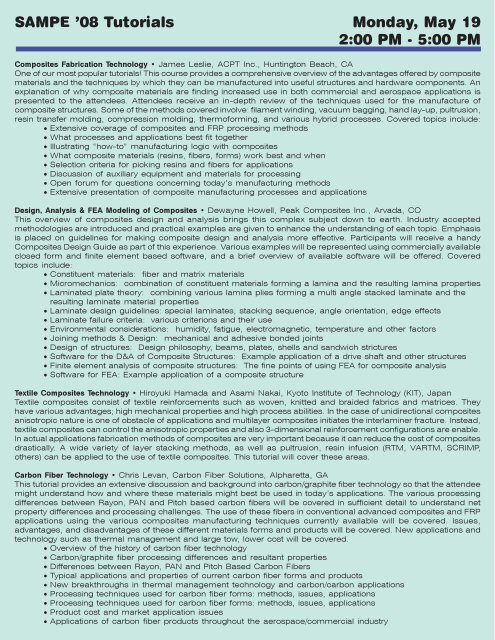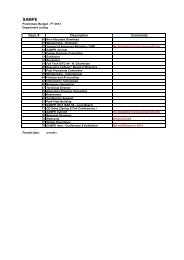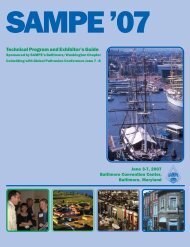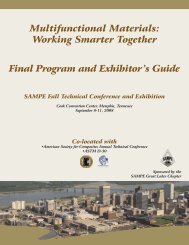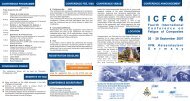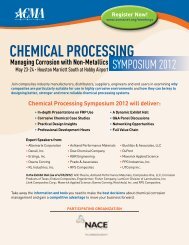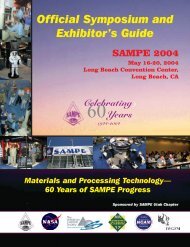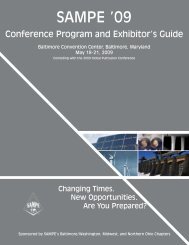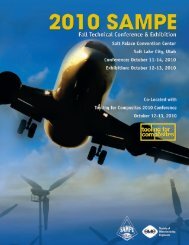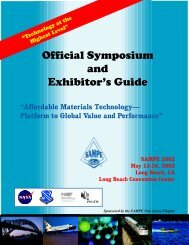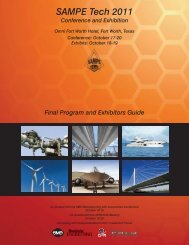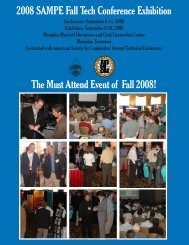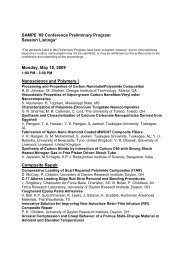Cincinnati Brochure - Sampe
Cincinnati Brochure - Sampe
Cincinnati Brochure - Sampe
Create successful ePaper yourself
Turn your PDF publications into a flip-book with our unique Google optimized e-Paper software.
SAMPE ’08 Tutorials Monday, May 19<br />
2:00 PM - 5:00 PM<br />
Composites Fabrication Technology • James Leslie, ACPT Inc., Huntington Beach, CA<br />
One of our most popular tutorials! This course provides a comprehensive overview of the advantages offered by composite<br />
materials and the techniques by which they can be manufactured into useful structures and hardware components. An<br />
explanation of why composite materials are finding increased use in both commercial and aerospace applications is<br />
presented to the attendees. Attendees receive an in-depth review of the techniques used for the manufacture of<br />
composite structures. Some of the methods covered involve: filament winding, vacuum bagging, hand lay-up, pultrusion,<br />
resin transfer molding, compression molding, thermoforming, and various hybrid processes. Covered topics include:<br />
• Extensive coverage of composites and FRP processing methods<br />
• What processes and applications best fit together<br />
• Illustrating “how-to” manufacturing logic with composites<br />
• What composite materials (resins, fibers, forms) work best and when<br />
• Selection criteria for picking resins and fibers for applications<br />
• Discussion of auxiliary equipment and materials for processing<br />
• Open forum for questions concerning today’s manufacturing methods<br />
• Extensive presentation of composite manufacturing processes and applications<br />
Design, Analysis & FEA Modeling of Composites • Dewayne Howell, Peak Composites Inc., Arvada, CO<br />
This overview of composites design and analysis brings this complex subject down to earth. Industry accepted<br />
methodologies are introduced and practical examples are given to enhance the understanding of each topic. Emphasis<br />
is placed on guidelines for making composite design and analysis more effective. Participants will receive a handy<br />
Composites Design Guide as part of this experience. Various examples will be represented using commercially available<br />
closed form and finite element based software, and a brief overview of available software will be offered. Covered<br />
topics include:<br />
• Constituent materials: fiber and matrix materials<br />
• Micromechanics: combination of constituent materials forming a lamina and the resulting lamina properties<br />
• Laminated plate theory: combining various lamina plies forming a multi angle stacked laminate and the<br />
resulting laminate material properties<br />
• Laminate design guidelines: special laminates, stacking sequence, angle orientation, edge effects<br />
• Laminate failure criteria: various criterions and their use<br />
• Environmental considerations: humidity, fatigue, electromagnetic, temperature and other factors<br />
• Joining methods & Design: mechanical and adhesive bonded joints<br />
• Design of structures: Design philosophy, beams, plates, shells and sandwich strictures<br />
• Software for the D&A of Composite Structures: Example application of a drive shaft and other structures<br />
• Finite element analysis of composite structures: The fine points of using FEA for composite analysis<br />
• Software for FEA: Example application of a composite structure<br />
Textile Composites Technology • Hiroyuki Hamada and Asami Nakai, Kyoto Institute of Technology (KIT), Japan<br />
Textile composites consist of textile reinforcements such as woven, knitted and braided fabrics and matrices. They<br />
have various advantages; high mechanical properties and high process abilities. In the case of unidirectional composites<br />
anisotropic nature is one of obstacle of applications and multilayer composites initiates the interlaminer fracture. Instead,<br />
textile composites can control the anisotropic properties and also 3-dimensional reinforcement configurations are enable.<br />
In actual applications fabrication methods of composites are very important because it can reduce the cost of composites<br />
drastically. A wide variety of layer stacking methods, as well as pultrusion, resin infusion (RTM, VARTM, SCRIMP,<br />
others) can be applied to the use of textile composites. This tutorial will cover these areas.<br />
Carbon Fiber Technology • Chris Levan, Carbon Fiber Solutions, Alpharetta, GA<br />
This tutorial provides an extensive discussion and background into carbon/graphite fiber technology so that the attendee<br />
might understand how and where these materials might best be used in today’s applications. The various processing<br />
differences between Rayon, PAN and Pitch based carbon fibers will be covered in sufficient detail to understand net<br />
property differences and processing challenges. The use of these fibers in conventional advanced composites and FRP<br />
applications using the various composites manufacturing techniques currently available will be covered. Issues,<br />
advantages, and disadvantages of these different materials forms and products will be covered. New applications and<br />
technology such as thermal management and large tow, lower cost will be covered.<br />
• Overview of the history of carbon fiber technology<br />
• Carbon/graphite fiber processing differences and resultant properties<br />
• Differences between Rayon, PAN and Pitch Based Carbon Fibers<br />
• Typical applications and properties of current carbon fiber forms and products<br />
• New breakthroughs in thermal management technology and carbon/carbon applications<br />
• Processing techniques used for carbon fiber forms: methods, issues, applications<br />
• Processing techniques used for carbon fiber forms: methods, issues, applications<br />
• Product cost and market application issues<br />
• Applications of carbon fiber products throughout the aerospace/commercial industry<br />
24


